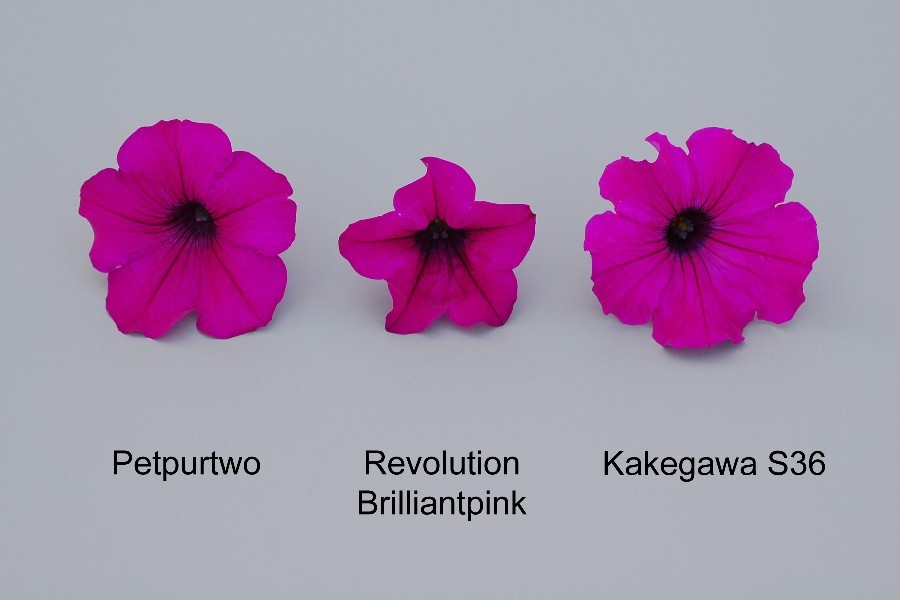Petpurtwo
| Denomination: | 'Petpurtwo' |
|---|---|
| Trade name: | Sanguna Deep Purple |
| Botanical Name: | Petunia ×hybrida |
| Applicant/Holder: |
Syngenta Seeds B.V. P.O. Box 2 1600 AA Enkhuizen Netherlands |
| Breeder: |
E. Barends, Syngenta Seeds B.V., Enkhuizen, Netherlands |
| Agent in Canada: |
BioFlora Inc. 38723 Fingal Line R.R. #1 St. Thomas, Ontario N5P 3S5 Canada Tel: 519-317-7511 |
| Application Date: | 2005-05-13 |
| Application Number: | 05-4892 |
| Date Withdrawn: | 2007-09-28 |
Variety Description
Varieties used for comparison: 'Revolution Brilliantpink' (Surfinia Brilliant Pink/Purple) and 'Kakegawa S36' (Supertunia Royal Magenta)
Summary: 'Petpurtwo' has a more erect growth habit than 'Revolution Brilliantpink' and a taller plant height than the reference varieties. 'Petpurtwo' has darker leaf colour than the reference varieties. 'Petpurtwo' has a narrower sepal width than the reference varieties. 'Petpurtwo' has weaker undulation of the corolla lobe than the reference varieties.
Description:
PLANT: semi-erect growth habit, medium to tall height, wide
SHOOTS: thin, medium to long, medium to very strong anthocyanin colouration
LEAVES: medium length, narrow to medium width, ovate to elliptic, narrow acute apex, no variegation, strong green on upper side, weak blistering present, short to medium length petiole
SEPALS: medium length, narrow to medium width, linear, anthocyanin colouration present
FLOWERS: short to medium length pedicel, single corolla, medium to large diameter, salverform shape
COROLLA: strong lobing, intense red purple on upper side, blue pink on lower side, veins purple and moderately conspicuous, margin with weak undulation
COROLLA TUBE: medium to long, violet on inner side, veins moderately to strongly conspicuous
ANTHERS: light blue before pollen dehiscence, medium blue after pollen dehiscence.
Origin & Breeding History: 'Petpurtwo' originated from a controlled cross made in 2000 in Enkhuizen, The Netherlands, between the female parent, 'W973-1' and the male parent 'Y862-1'. A plant was selected from the resultant progeny of the cross in 2001, based on early flowering, flower characteristics and plant habit. Asexual reproduction by vegetative cuttings was first conducted in August, 2001 in Enkhuizen, The Netherlands.
Tests & Trials: The tests and trials for 'Petpurtwo' were conducted in a polyhouse at BioFlora in St. Thomas, Ontario in the spring of 2006. The trials included 15 plants of each variety. Rooted cuttings were transplanted into six inch pots on April 17, 2006. Observations and measurements were taken from 10 plants of each variety. All colour measurements were made using the 2001 Royal Horticultural Society Colour Chart.
Comparison tables for 'Petpurtwo' with reference varieties 'Revolution Brilliantpink' and 'Kakegawa S36'
Plant height (cm)
| 'Petpurtwo' | 'Revolution Brilliantpink' | 'Kakegawa S36' | |
|---|---|---|---|
| mean | 23.6 | 10.0 | 13.8 |
| std. deviation | 3.59 | 2.12 | 2.53 |
Sepal width (mm)
| 'Petpurtwo' | 'Revolution Brilliantpink' | 'Kakegawa S36' | |
|---|---|---|---|
| mean | 3.3 | 6.1 | 4.6 |
| std. deviation | 0.48 | 1.29 | 0.70 |
Colour of corolla (RHS)
| 'Petpurtwo' | 'Revolution Brilliantpink' | 'Kakegawa S36' | |
|---|---|---|---|
| upper side | N74A (more intense than) | N74A (more intense than) | N74A (more pink than) |
| lower side | 72C | N74B | N81C and 71D around margins |
Colour of corolla tube (RHS)
| 'Petpurtwo' | 'Revolution Brilliantpink' | 'Kakegawa S36' | |
|---|---|---|---|
| inner side | N81B | N81B | 83B-C |
Click on image for larger view

Petunia: 'Petpurtwo' (left) with reference varieties 'Revolution Brilliantpink' (centre) and 'Kakegawa S36' (right)
- Date modified: